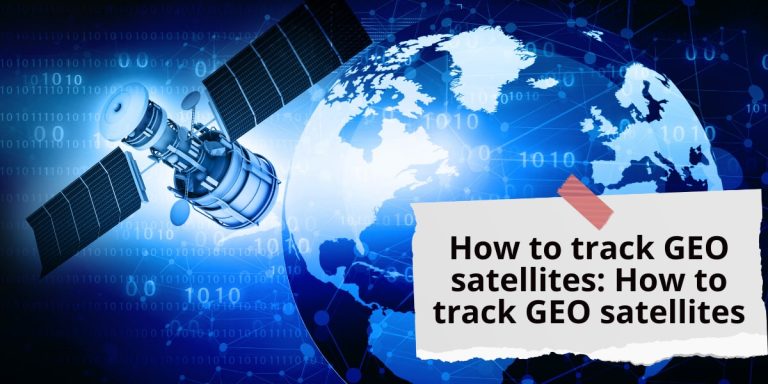How to track GEO satellites: How to track GEO satellites
What is GEO Satellite Tracking?
GEO satellite tracking refers to the process of monitoring the positions, trajectories, and movements of geostationary satellites in real-time or near-real-time. Tracking GEO satellites enables users to predict their orbits, track their movements across the sky, and communicate with them effectively for various purposes, including telecommunications, broadcasting, and scientific research.
Importance of Tracking GEO Satellites
Tracking GEO satellites is essential for ensuring their proper operation, optimizing communication links, and avoiding collisions with other satellites or debris in orbit. By accurately tracking GEO satellites, operators can monitor their health, adjust their orbits if necessary, and maintain uninterrupted service for users relying on satellite-based services.
Methods of Tracking GEO Satellites
Ground-Based Observations
Ground-based observers utilize telescopes, binoculars, and tracking software to visually observe and track GEO satellites as they traverse the sky. By tracking the apparent movement of satellites relative to the background stars, observers can estimate their positions and trajectories with precision.
Satellite Tracking Networks
Satellite tracking networks, operated by government agencies, research institutions, and commercial organizations, use ground-based tracking stations equipped with radar, radio telescopes, and optical instruments to track satellites in orbit. These networks provide continuous monitoring and tracking capabilities, enabling operators to maintain communication links and monitor the health of satellites in real-time.
Satellite Tracking Apps and Websites
Satellite tracking apps and websites provide real-time tracking information and predictions for satellites based on their orbital parameters. Users can input the satellite’s name or NORAD ID to track its current position, upcoming passes, and visibility from their location. Examples include Heavens-Above, Satflare, and N2YO.
Satellite Tracking Software
Satellite tracking software, such as STK (Systems Toolkit), Orbitron, and GPredict, offers advanced tools for simulating satellite orbits, predicting future positions, and analyzing orbital parameters. These software applications are used by professionals and enthusiasts for satellite tracking and analysis.
Amateur Radio Tracking:
Amateur radio enthusiasts track satellites by monitoring the signals emitted by satellites using radio frequency (RF) tracking techniques. By tracking the Doppler shift of satellite signals, radio operators can estimate the satellite’s velocity and position relative to their location. Examples include tracking satellites using software-defined radios (SDRs) and dedicated satellite tracking antennas.
Optical Tracking Stations
Optical tracking stations equipped with telescopes and cameras are used to visually track satellites and capture images for identification and analysis. These stations are often part of satellite tracking networks operated by space agencies and research institutions.
Radar Tracking
Radar tracking involves bouncing radar signals off satellites and analyzing the returned signals to determine the satellite’s position, velocity, and trajectory. Radar tracking stations use high-frequency radar systems to track satellites in low Earth orbit (LEO) and geostationary orbit (GEO).
Laser Ranging
Laser ranging stations use laser beams to measure the distance to satellites with extreme precision. By timing the round-trip travel of laser pulses reflected off satellites, ranging stations can calculate the satellite’s distance and orbit parameters.
GPS Tracking
GPS receivers onboard satellites enable tracking of their positions and orbits using signals from the Global Positioning System (GPS). Ground-based receivers track GPS signals transmitted by satellites to determine their positions and orbits.
Satellite Tracking Databases
Satellite tracking databases compile orbital data and predictions for thousands of satellites, allowing users to search for specific satellites and track their movements over time. These databases provide valuable information for satellite enthusiasts, researchers, and operators.
Tools and Resources for GEO Satellite Tracking
Satellite Tracking Software
Satellite tracking software, such as STK (Systems Toolkit), Orbitron, and GPredict, provides advanced tools for tracking and visualizing the orbits of GEO satellites. These software applications allow users to simulate satellite orbits, predict future positions, and analyze orbital parameters with precision.
Amateur Radio Tracking
Amateur radio enthusiasts use radio frequency (RF) tracking techniques to monitor the signals emitted by GEO satellites. By tracking the Doppler shift of satellite signals, radio operators can estimate the satellite’s velocity and position relative to their location.
Real-World Applications
Telecommunications
Telecommunication companies and satellite operators rely on GEO satellite tracking to maintain communication links and optimize signal coverage for users. By tracking satellite positions and adjusting ground station antennas accordingly, operators can ensure reliable communication services for customers around the world.
Broadcasting
Broadcasting companies use GEO satellite tracking to monitor the positions of broadcasting satellites and align receiving antennas for optimal signal reception. By tracking satellite positions in real-time, broadcasters can maintain uninterrupted transmission of television, radio, and multimedia content to viewers and listeners.
Key Takeaways
- GEO satellite tracking is essential for monitoring satellite positions, trajectories, and movements in real-time.
- Ground-based observations, satellite tracking networks, and satellite tracking apps are commonly used methods for tracking GEO satellites.
- Satellite tracking software and amateur radio tracking techniques provide advanced tools for analyzing satellite orbits and predicting future positions.
- Real-world applications of GEO satellite tracking include telecommunications, broadcasting, and scientific research.
How to track GEO satellites: How to track GEO satellites conclusion
In conclusion, tracking GEO satellites is a vital aspect of satellite operations, enabling operators to ensure optimal performance, maintain communication links, and deliver essential services to users around the world. By leveraging various tracking methods and tools, researchers, enthusiasts, and professionals can unravel the mysteries of GEO satellites and unlock their full potential in the vast expanse of space.

